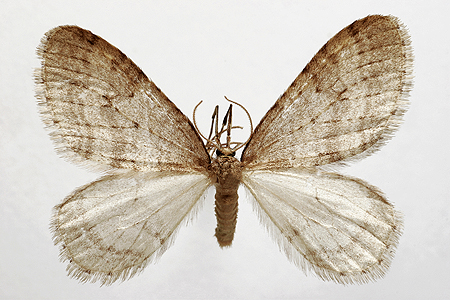Pests
Operophthera brumata L. - Winter Moth
Systematic position.
Class Insecta, order Lepidoptera, family Geometridae, genus Operophtera.Synonym.
Cheimatobia brumata L.Biological group.
This is a polyphagous pest of fruit and berry cultures and foliaceous trees and bushes.Morphology and biology.
Sexual dimorphism is sharply developed. Male forewings are brownish-gray with dark transversal wavy lines, slightly transparent (wingspan 20-25 mm). Hind wings lighter, monochromatic. Female has reduced wings (body length is 7.5-10 cm; wing length is 2-3 mm). Eggs are oval, initially bluish or yellowish-light-green, later becoming yellowish-orange or pink. Caterpillars are yellowish-green with dark longitudinal dorsal line and 3 white lateral stripes, with light-brown head. Pupae are 7.5-7.9 mm long and light brown with bifurcated disto-apical spine. Eggs over-winter. Embryonic development begins in late autumn, stopping in a phase of embryonic strip surrounded with blastoderms, then proceeding in spring. For its reactivation the effect of negative winter temperatures is necessary. Hatching caterpillars gnaw out holes in blossoming buds, plaiting some of young leaves with silk threads. Later they roughly eat around leaves, buds, flowers, and fruitlets. Development of caterpillars lasts 3-4 weeks at favorable air temperatures (14-19°C). Older caterpillars are inactive, resting on the lower side of leaves; pupation occurs in the ground in weak oval cocoons. Development of pupa lasts 3-4 months. Apterous females lay up to 400 eggs one by one or in small groups at tips of branches near buds.Distribution.
This species lives in Western, Northern and Middle Europe, in Japan. It is adventive in Canada. In the former USSR it is distributed in the European part (northward and eastward to Karelia, Arkhangelsk and Kirov Regions, and Bashkiria), in the Northern Caucasus, Transcaucasia, Ukraine (including Crimea), the Far East (Amur Region, Khabarovsk and Primorskii territories).Ecology.
This species is monovoltine. Caterpillars hatch at the beginning of bud blossoming, at degree days 80° C (with a threshold of 6°C). They develop from the middle of April until the end of June, pupating in May-June in the ground at a depth of 1.5-15 cm. Moths fly from the end of September until the end of November, in the south they fly in January-February, easily enduring short-term frosts down to -15°C. Males appear 3-4 days before females, being active at twilight and night. The most active flight is observed at air temperatures of 7-12°C. Development of eggs begins in autumn at temperatures -2.5 to 26°C. Being a luciphile and thermophilic pest, the Winter Moth readily settles trees in open sites, causing the strongest damage to well insolated parts of crown.Economic significance.
These polyphagous caterpillars develop on almost all fruit trees (apple, pear, cherry, sweet cherry, plum, peach, apricot, quince), on shadberry, bird cherry, hawthorn, mountain ash, dogrose, raspberry, wild strawberry, cotoneaster, biwa, filbert, pomegranate, grapevine, black and red currant, gooseberry, and also on oak, beech, hornbeam, elm, maple, chestnut, ash-tree, linden, willow, aspen, poplar, alder, hazel, guelder-rose, honeysuckle, Persian lilac. They damage the buds, leaves, flower buds, and also ovaries of stone-fruit species. Caterpillars can destroy the foliage of trees as much as 75%.Control measures.
Agronomical measures in gardens include the treatment of ground during the summer period for the destruction of pupae, the application of sticky trapping bands in autumn for female catching. Biological measures include the application of biological preparations during bud blossoming (at daily average temperature 15 degree C and higher). Chemical measures include insecticide treatments of fruit trees before flowering for the destruction of eggs and caterpillars.Reference citations:
Belyaev E.A. 1988. Family Geometridae. In: Kirpichnikova V.A., Ler P.A., eds. Butterflies - pests of the Far Eastern agriculture. Keys. Vladivostok: DVO AN SSSR. 130-149 p. (In Russian)Milyanovskii E.S. 1974. Family Geometridae. In: Vasil.ev V.P., ed. Pests of agricultural crops and forest plantations. V. 2. Arthropods. Kiev: Urozhai. 343-352 p. (In Russian)
Mironov V.G. 1999. Family Geometridae. In: Kuznetsov V.I., ed. Insects and mites - pests of agricultural crops. Lepidoptera. V. 3(2). St. Petersburg: Nauka. 254-273 p. (In Russian)
Savkovskii P.P. 1976. Atlas of the pests of fruit and berry plants. Kiev: Urozhai. 207 p. (In Russian)
Vasil.ev V.P., Livshits I.Z. 1984. Pests of fruit crops. Moscow: Kolos. 399 p. (In Russian)


